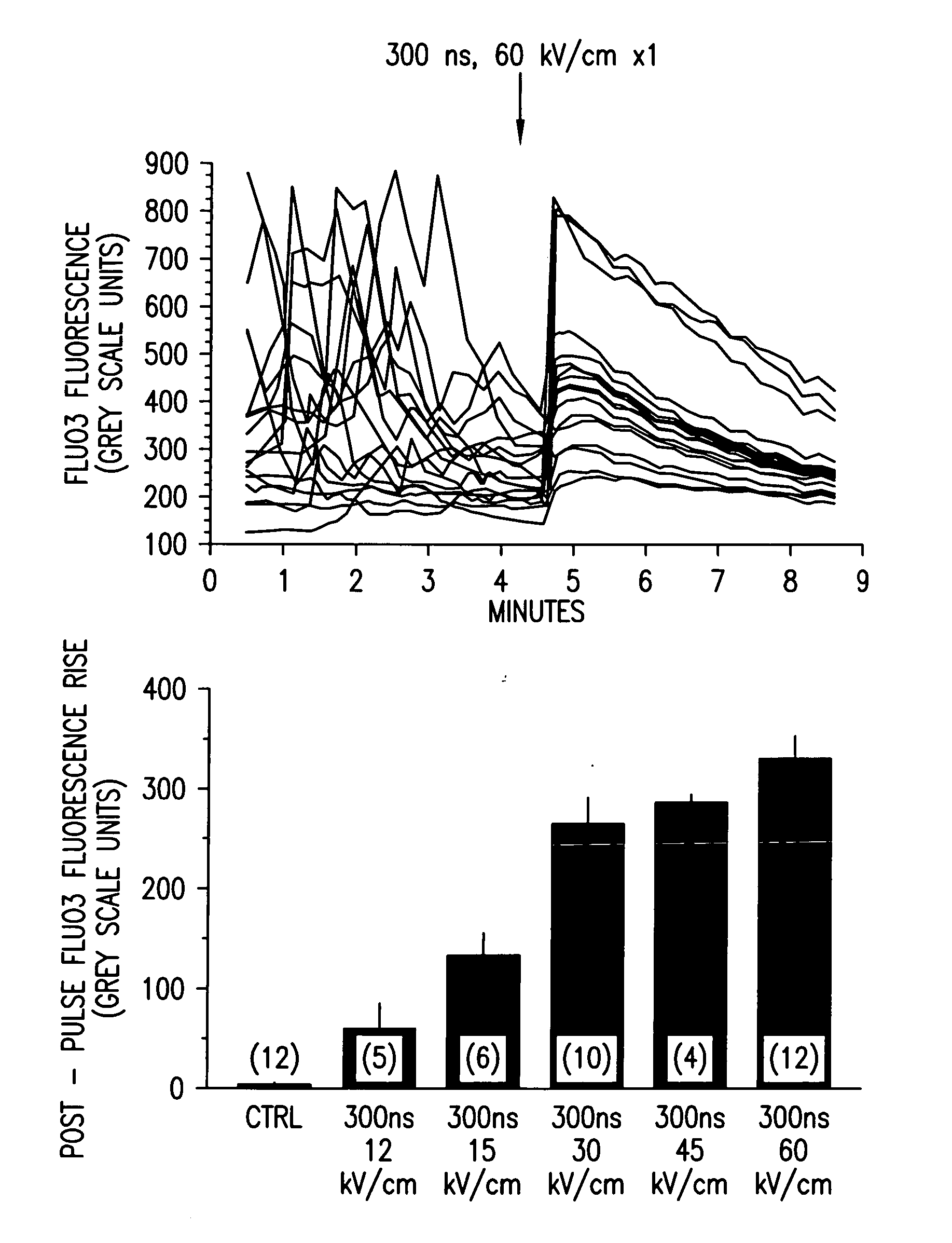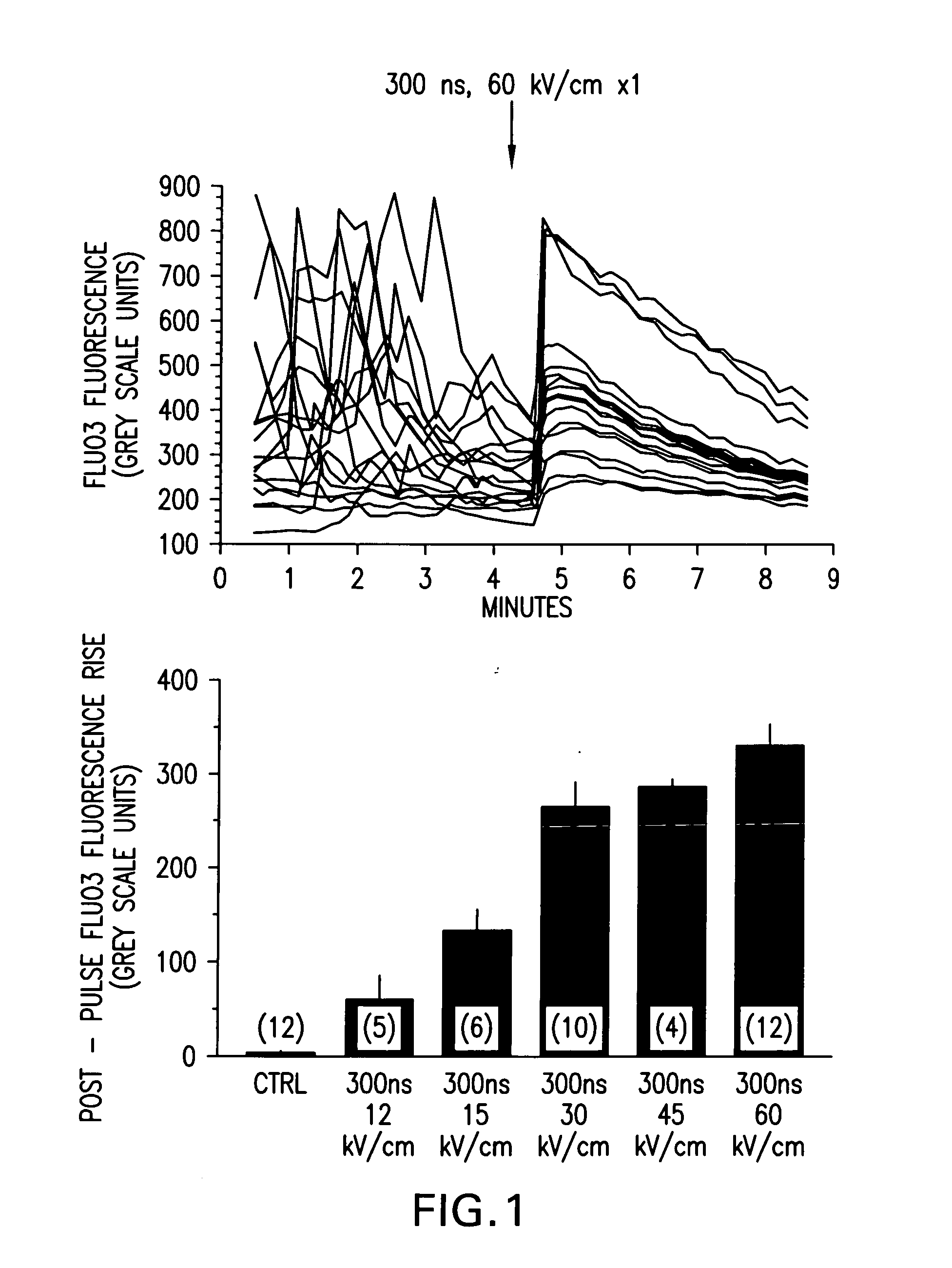Activation of calcium-mediated cell functions in cells and tissues, including aggregation of human platelets, by nanosecond pulsed electric fields
a technology of nanosecond pulsed electric fields and cell functions, applied in electrotherapy, therapy, etc., can solve the problems of allergic reactions, high cost of treatment, and contamination of platelet rich plasma (prp) with infectious agents, and achieve the effect of increasing intracellular calcium and increasing intracellular calcium in the cell
- Summary
- Abstract
- Description
- Claims
- Application Information
AI Technical Summary
Benefits of technology
Problems solved by technology
Method used
Image
Examples
example 1
nsPEFs Induce Increases in Intracellular Calcium Using Human Neutrophils
[0054]FIG. 1 demonstrates qualitative [Ca2+]i responses of polymorphonuclear leukocytes (PMNs) to nsPEF applications. Fluo3 labeled PMNs were examined by fluorescence microscopy before and following a single 300 ns, 60 kV / cm pulse application (upper panel). Each line is the grey-scale intensity (averaged over a spot (17 pixel diameter) within the cell) representation of intracellular Fluo3 fluorescence observed in one cell in the microscopic field. The highly variable Fluo3 fluorescence observed from cell-to-cell is due to changes in [Ca2+]i as the cells moved on the pulsing electrode surface. Application of a single nsPEF to the cells resulted in a rapid, variable increase in [Ca2+]i that waned in most cells over 4-5 minutes, loss of spontaneous fluctuations in [Ca2+]i and immediate loss of cellular movement. Lower panel shows dose-response relationship between intensity of the single pulse and the mean±S.E.M....
example 2
Investigation of nsPEF-Induced Apoptosis and Caspase Activation in Order to Determine Whether Calcium-Dependent or Calcium-Independent Cellular Mechanisms were Being Activated During Apoptosis
Materials and Methods
[0056] Cell culture—Non-transformed HL-60 and Jurkat cells were obtained from and cultured as recommended by American Type Culture Collection (ATCC, Rockville, Md.) as previously described (Beebe, S. J., et al. (2002). IEEE Trans. Plasma Sci. 30:1 Part 2, 286-292; Beebe, S. J., et al. (2003). FASEB J. 17, 1493-1495). Cells were removed from log phase growth and suspended in Hanks Balanced Salt Solution (HBSS) in the presence or absence of Ca2+ and Mg2+. When calcium was omitted, cells were washed several times in buffer without added calcium. In other experiments, the calcium chelator BAPTA was added to chelate intracellular calcium. Cells were loaded with BAPTA-AM and washed in HBSS before the addition of agonists.
[0057] Administration of nsPEF—Cell suspensions (7.7×10...
example 3
Investigation of nsPEF Stimulation at Electric Fields Below the Threshold for Apoptosis in Order to Explore Non-Apoptotic Internal Calcium Responses to nsPEF
[0063] The effects of nsPEFs on the release of internal calcium and activation of calcium influx in HL-60 cells were also investigated using real-time fluorescent microscopy with Fluo-3 and fluorometry with Fura-2. nsPEFs induced an increase in intracellular calcium levels that was seen in all cells. With pulses of 60 ns duration and electric fields between 4 and 15 kV / cm, intracellular calcium increased 200 nM-700 nM, respectively, above basal levels (˜100 nM) while the uptake of propidium iodide was absent. This suggests that increases in intracellular calcium were not due to plasma membrane electroporation. nsPEF and the purinergic agonist UTP induced calcium mobilization in the presence and absence of extracellular calcium with similar kinetics and appeared to target the same IP3- and thapsigargin-sensitive calcium pools in...
PUM
 Login to View More
Login to View More Abstract
Description
Claims
Application Information
 Login to View More
Login to View More - R&D
- Intellectual Property
- Life Sciences
- Materials
- Tech Scout
- Unparalleled Data Quality
- Higher Quality Content
- 60% Fewer Hallucinations
Browse by: Latest US Patents, China's latest patents, Technical Efficacy Thesaurus, Application Domain, Technology Topic, Popular Technical Reports.
© 2025 PatSnap. All rights reserved.Legal|Privacy policy|Modern Slavery Act Transparency Statement|Sitemap|About US| Contact US: help@patsnap.com



